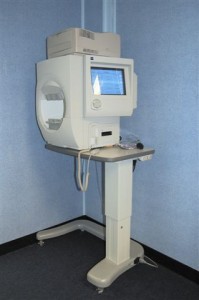So says the Humphrey-Zeiss field analyzer, anyway.

Yep. Apparently I let my eye move around to look for the little flashing white lights rather than stay fixed on the central yellow one, and in the optometrist’s vernacular, that means I am a cheater. That’s item number one on the list of things the machine tests for:
The field report generated by modern visual field devices includes a wealth of information, all of which can be useful to the doctor interpreting the results:
- Fixation errors: the number of times the patient looks away from the central target. This is a key indicator of patient cooperation or fatigue.
- False positives: the number of times the patient pushes the button when, in reality, a light source is not illuminated.
- False negatives: the number of times the patient fails to push the button when, in reality, there is a light source illuminated. These spots can be repeat tested by the onboard computer at exactly the same spot to best understand the patient’s ability to produce an accurate field test.
- There are four more kinds of data generated.
More practically, it means I have to come back and do it again. The whole point is to see whether my optic nerves show any signs of glaucoma damage to the optic nerve.